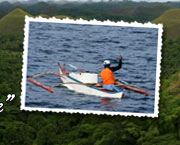Marine-Life Study Finds Dozens of New Species in Panglao
IJsselstein, Saturday, 10 July 2004
During an intensive study of marine life around Panglao Island, Bohol, a French researcher has collected thousands of different sea animals such as crabs, shells, sea slugs, and shrimps. Among these dozens of species that are new to science.
The Panglao Marine Biodiversity Project 2004 took place for a period of six weeks in May and June 2004. It was headed by the French researcher Dr. Philippe Bouchet, a senior professor at The National Museum of Natural History (Muséum National d'Histoire Naturelle, MNHN), in cooperation with Dr. Danilo Largo, chairman of the Biology Department at the University of San Carlos, Cebu.
To perform the study, no less than 80 scientists, from 17 different countries came to Panglao with diving, dreging and trawling equipment. Operating from the coasts of the town of Panglao, including the well known tourist destination Alona Beach, they collected species from a number of different marine biotopes, such as coral reefs, shallow and deep water, undersea cliffs, seagrass or seaweed beds, sandy and muddy seabeds, mangrove forests. Panglao was specically choosen for this study, as all these different biotopes can be found here within a few kilometres from each other. Combined with the fact that Panglao has relatively good communication and road infrastructure, this makes Panglao a unique location for biodiversity research.
With a special permit from the Department of Agriculture, and special equipment, the sea creatures where collected from depths over 80 metres deep, photographed, and catalogued. Just one number: no less than 1200 different species of crabs and shrimbs where collected around Panglao, whereas Japan has about 1600 different species. Already in this stage of the study, it is clear that among the many creatures collected, there are numerous newly discovered animals. Most of these are tiny slugs, shrimps, or crabs just a few millimetres tall, but some are larger. The biggest newly discovered species is a crab, which is so well camouflaged that it is no wonder it was never discovered before. From the top it looks just like a rough stone, and only when it is turned upside down, the legs, eyes and mouth become visible.
Another surprising discovery was that many creatures that normally live in water of 250 to 400 metres deep were found thriving in waters just 70 to 80 metres deep near Panglao.
Now that the collecting phase of the project has ended, the collected animals will be further studied in detail, at the various institutes, for precise determination and to proof that the newly discovered species are truly new to science. If that is the case, the newly discovered animals will receive a name, and it is very likely a few of these will be named "boholensis," after the island of Bohol!
The project is supported by the French Ministry of Foreign Affairs and the Total Foundation. The field research phase costed 220,000 euros (nearly 15 million pesos).
Although will still take a few of years for all the results of the study to become available, one thing is already clear from the astounding number of species discovered, that is that the environment around Panglao is uniquely diverse, and worthy of protection and preservation, and initiatives that threaten this unique ecosystem should be avoided.
Further Reading
The website of the Panglao Marine Biodiversity Project 2004. This contains numerous articles and many very nice photographs of molluscs, crabs, shrimbs, etc. Also included is an explanation in Cebuano.
The website of One Ocean, with many interesting materials about coastal resource management in the Philippines.
Jeroen Hellingman
What readers think...
| Blue Freedom Apnea wrote: |
| Monday, 6 January 2020 12:16:38 PHT |
| There is new freediving school open in Panglao, Bohol. They are non-profit organization that offer AIDA and Molchanovs courses from beginner level to instructor level. If you want to explore Balicasag island in Panglao, you can also do fun dive with them. Checkout their website is https://bluefreedomapnea.com . You can also send an enquiry to their enquiry page Send Enquiry. #freedive #freediving panglao #freediving bohol #freediving philippines |
| clyde bodiongan wrote: |
| Thursday, 14 January 2010 15:49:05 PHT |
| thank you for exploring the marine world of panglao..i am hoping that the richness of the marine biodiversity will last forever keeping it safe.. |
| Michelle Villamayor wrote: |
| Sunday, 9 October 2005 09:49:10 PHT |
| I was searching the internet about the recently concluded expedition also held at Panglao for this year, 2005. I was very surprised to read this article. I'd like to add some bits of information: the Philippines is currently sustaining more than 500 Marine Protected Areas throughout the country. The government and academic institutes, however, are striving to extablish more so that one-half of the total shelf of the archipelago will be sustained. It's a long term project but very feasible. |
| Jupac wrote: |
| Wednesday, 13 April 2005 01:15:17 PHT |
| I think marine biology is really cool and one day i will be a shark. POWER TO THE SHARKS!! also, listen to the manatee man and save the sharks, man. Que Sera Sera. |
| Leo Udtohan wrote: |
| Wednesday, 15 September 2004 14:32:56 PHT |
| Article length comment placed here--Jeroen. |
Read all 9 comments by readers.
Also give your comments on this article
We reserve the right to remove or edit comments posted on this website. Please read our conditions of use for details. You can use <i>italics</i>, <b>bold</b>, <p> new paragraph, <a href="url">link</a>. Other markup will be removed. Use of the forums for advertising is prohibited. Enterprises located in Bohol can request to be added to the business directory.





